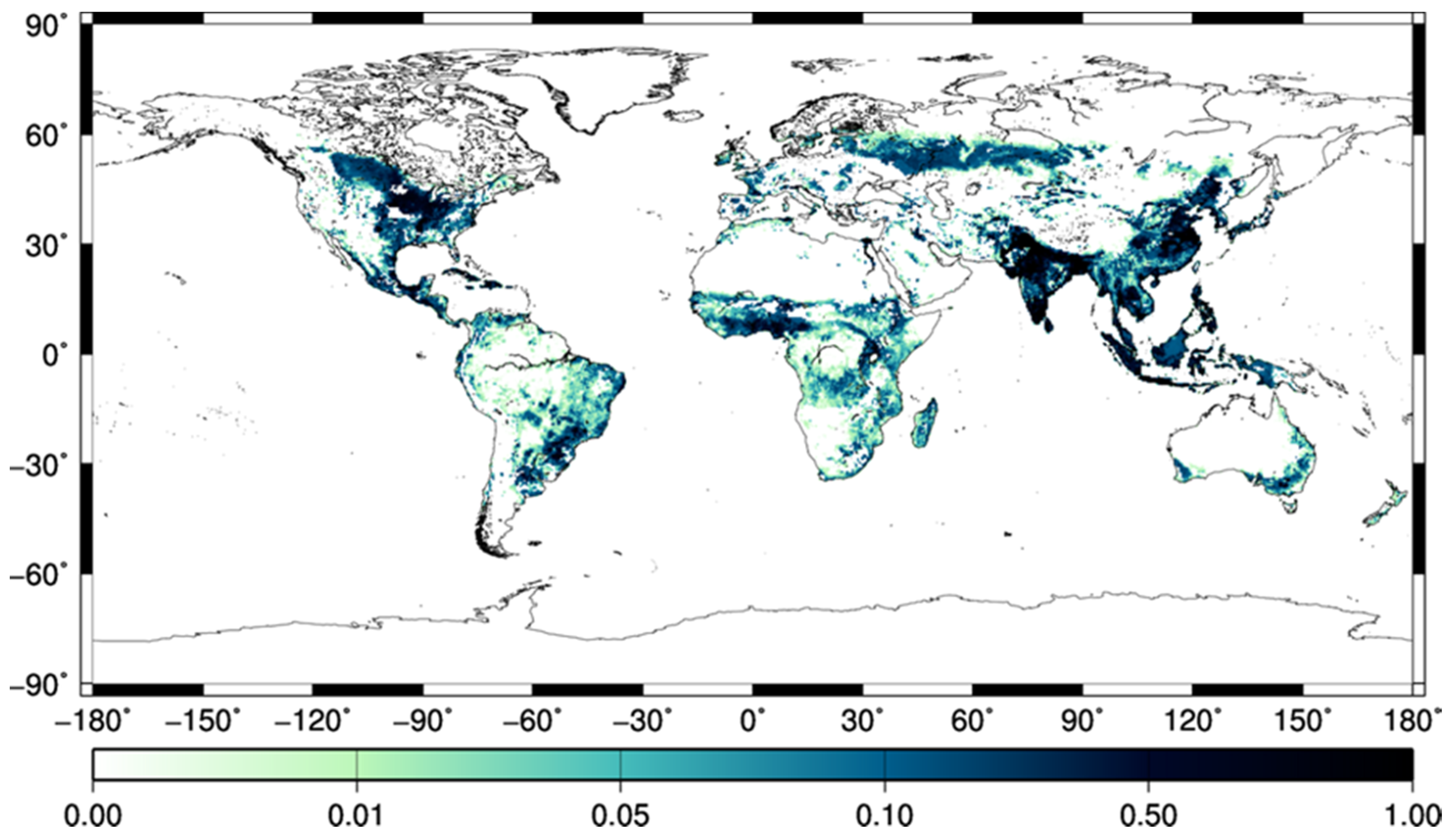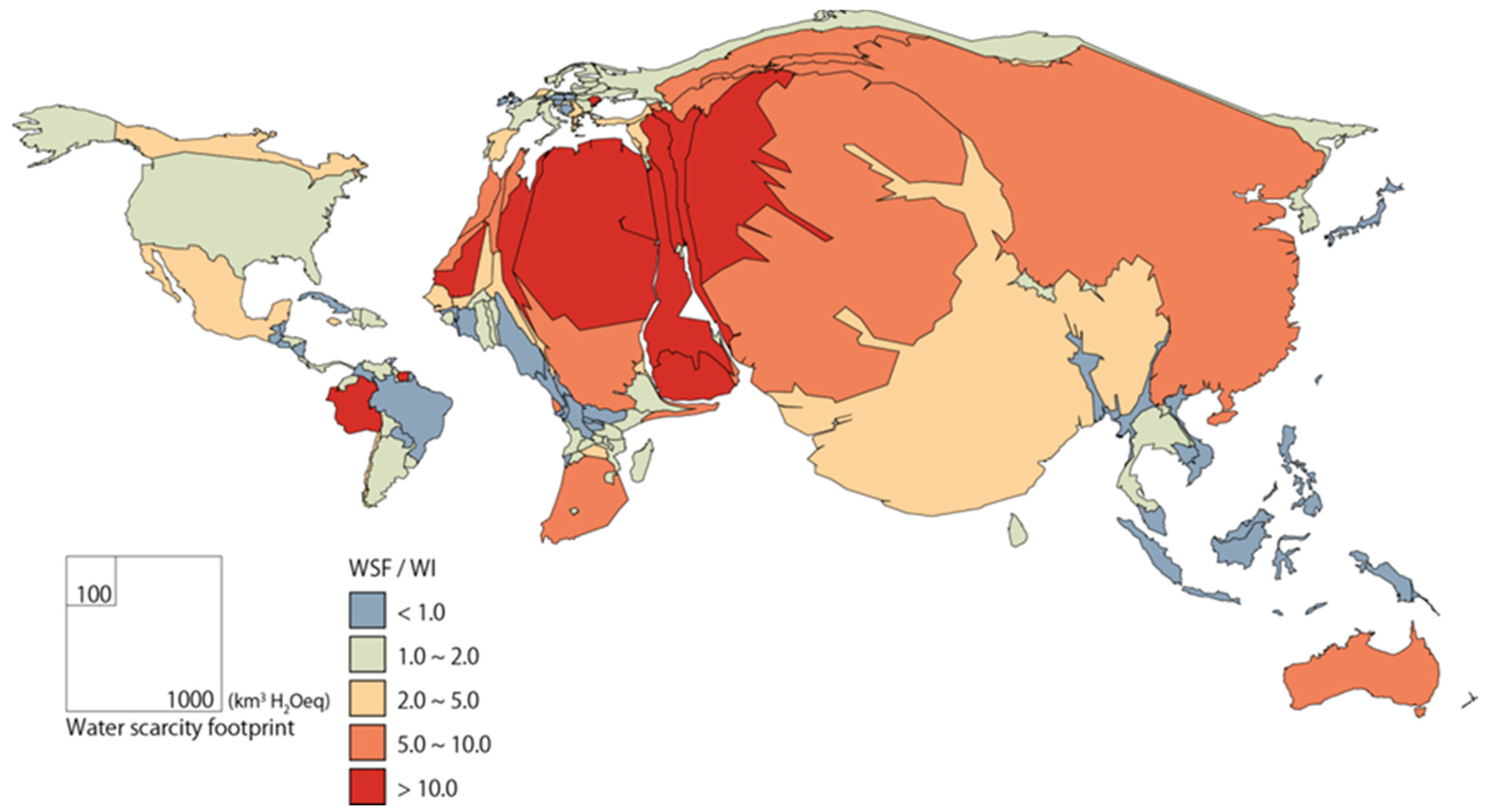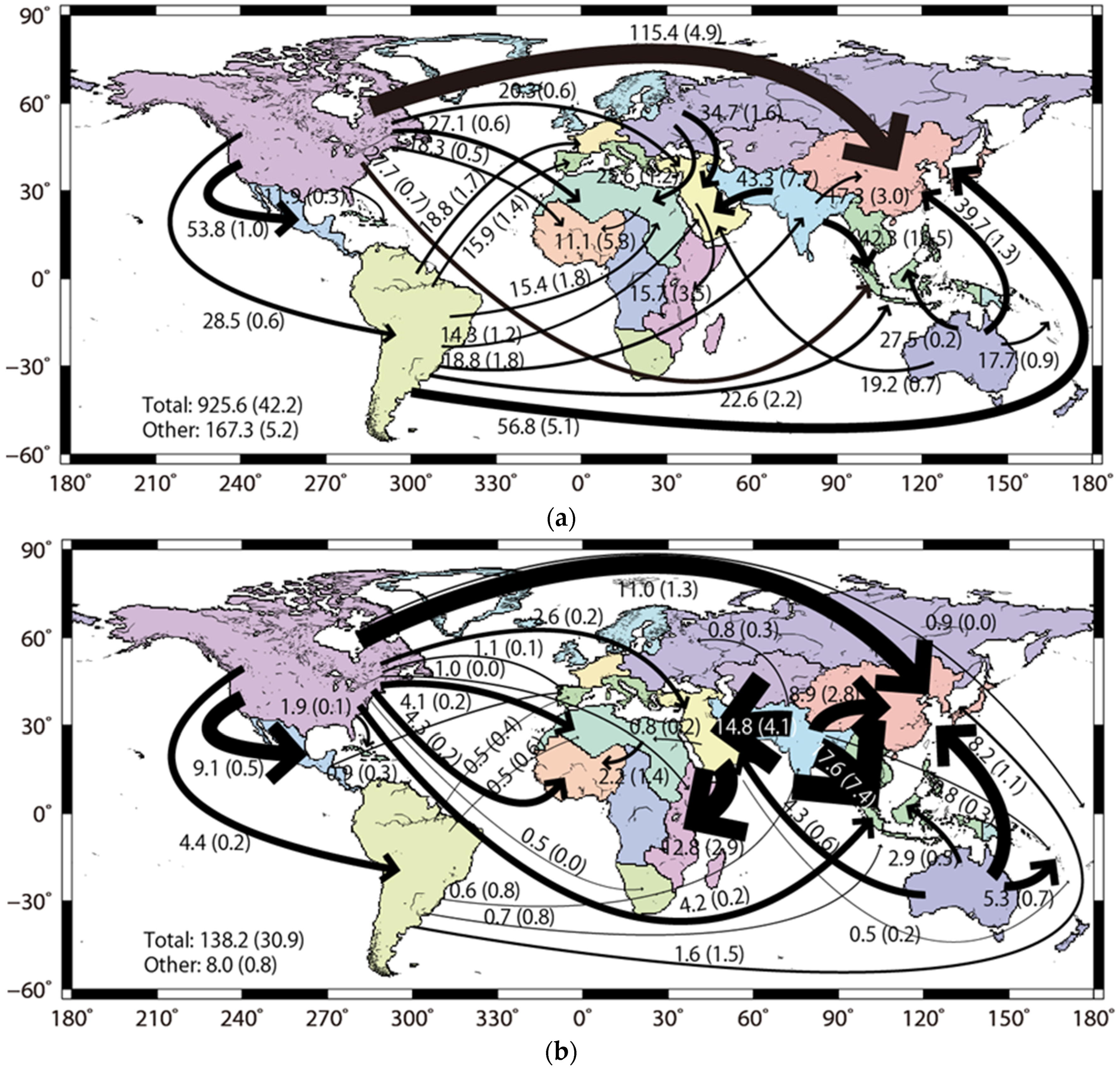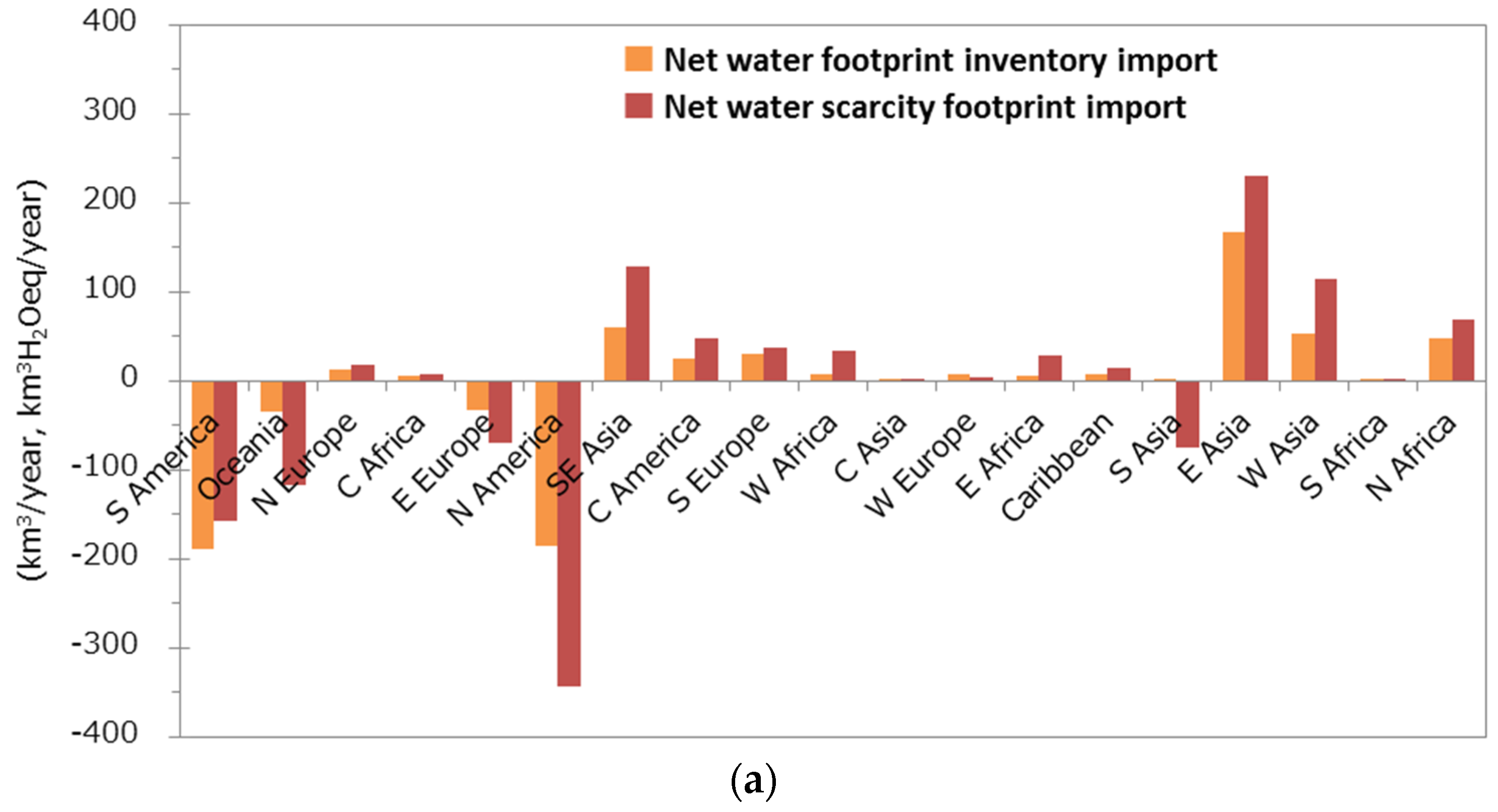Potential Impacts of Food Production on Freshwater Availability Considering Water Sources
Abstract
:1. Introduction
2. Materials and Methods
2.1. Calculation of the Water Footprint Inventory
2.2. Water Scarcity Footprint Assessment
3. Results
3.1. Water Footprint Inventory and the Water Scarcity Footprint of Global Food Production
3.2. Water Scarcity Footprint Flows Based on Food Trade
4. Discussion
- Irrigated croplands are limited due to low GDP levels (e.g., South America and Central Africa), resulting in limited water resource utilization;
- Industrial structures have not been developed due to low GDP levels, which has led to minimal competitive and small-scale agricultural practices and low levels of water resource utilizations;
- Water resource development is difficult to achieve due to low GDP and low technological capacity levels, resulting in low water resource utilization;
- High costs of infrastructure use imply high costs for water use, resulting in low water resource utilization; and
- Climatic conditions are not conductive to intensive agriculture (e.g., Northern Europe [34]), causing individuals to not utilize domestic water resources adequately.
5. Conclusions
Supplementary Materials
Acknowledgments
Author Contributions
Conflicts of Interest
Abbreviations
| fwua | water unavailability factor |
| WI | water footprint inventory |
| WSF | water scarcity footprint |
References
- The 2030 Water Resources Group. Charting our Water Future: Economic Frameworks to Inform Decision-Making; McKinsey & Company: New York, NY, USA, 2009. [Google Scholar]
- Foley, J.A.; Ramankutty, N.; Brauman, K.A.; Cassidy, E.S.; Gerber, J.S.; Johnston, M.; Mueller, N.D.; O’Connell, C.; Ray, D.K.; West, P.C.; et al. Solutions for a cultivated planet. Nature 2011, 478, 337–342. [Google Scholar] [CrossRef] [PubMed]
- Food and Agriculture Organization of the United Nations (FAO). The State of the World’s Land and Water Resources for Food and Agriculture (SOLAW)—Managing Systems at Risk; FAO: Rome, Italy, 2011. [Google Scholar]
- Postel, S.L.; Daily, G.C.; Ehrlich, P.R. Human appropriation of renewable fresh water. Science 1996, 271, 785–788. [Google Scholar] [CrossRef]
- Rockström, J.; Stefen, W.; Noone, K.; Persson, A.; Chapin, F.S.; Lambin, E.F.; Lenton, T.M.; Scheffer, M.; Folke, C.; Schellnhuber, H.J.; et al. A safe operating space for humanity. Nature 2009, 461, 472–475. [Google Scholar] [CrossRef] [PubMed]
- Gerten, D.; Hoff, H.; Rockström, J.; Jägermeyr, J.; Kummu, M.; Pastor, A.V. Towards a revised planetary boundary for consumptive freshwater use: Role of environmental flow requirements. Curr. Opin. Environ. Sustain. 2013, 5, 551–558. [Google Scholar] [CrossRef]
- The United Nations Educational, Scientific and Cultural Organization (UNESCO). Managing Water under Uncertainty and Risk (Vol. 1); The United Nations World Water Development Report 4; UNESCO: Paris, France, 2012. [Google Scholar]
- Hoekstra, A.Y.; Mekonnen, M.M.; Chapagain, A.K.; Mathews, R.E.; Richter, B.D. Global monthly water scarcity: Blue water footprints versus blue water availability. PLoS One 2012, 7, e32688. [Google Scholar]
- Allan, J.A. Virtual water: A strategic resource global solutions to regional deficits. Groundwater 1998, 36, 545–546. [Google Scholar] [CrossRef]
- Hoekstra, A.Y.; Hung, P.Q. Virtual Water Trade, A Quantification of Virtual Water Flows between Nations in Relation to International Crop Trade; Value of Water Research Report Series No. 11; UNESCO-IHE: Delft, The Netherland, 2002. [Google Scholar]
- Aldaya, M.M.; Llamas, M.R. Water Footprint Analysis for the Guadiana River Basin; Value of Water Research Report Series No. 35; UNESCO-IHE: Delft, The Netherland, 2008. [Google Scholar]
- Hanasaki, N.; Inuzuka, T.; Kanae, S.; Oki, T. An estimation of global virtual water flow and sources of water withdrawal for major crops and livestock products using a global hydrological model. J. Hydrol. 2010, 384, 232–244. [Google Scholar] [CrossRef]
- Hoekstra, A.Y.; Mekonnen, M.M. The water footprint of humanity. PNAS 2012, 109, 3232–3237. [Google Scholar] [CrossRef] [PubMed]
- Oki, T.; Kanae, S. Global hydrological cycles and world water resources. Science 2006, 313, 1068–1072. [Google Scholar] [CrossRef] [PubMed]
- Mekonnen, M.M.; Hoekstra, A.Y. National Water Footprint Accounts: the Green, Blue and Grey Water Footprint of Production and Consumption; Value of Water Research Report Series No. 50; UNESCO-IHE: Delft, The Netherland, 2011. [Google Scholar]
- Boulay, A.M.; Hoekstra, A.Y.; Vionnet, S. Complementarities of water-focused life cycle assessment and water footprint assessment. Environ. Sci. Technol. 2013, 47, 11926–11927. [Google Scholar] [CrossRef] [PubMed]
- Manzardo, A.; Mazzi, A.; Loss, A.; Butler, M.; Williamson, A.; Scipioni, A. Lessons learned from the application of different water footprint approaches to compare different food packaging alternatives. J. Clean. Prod. 2016, 112, 4657–4666. [Google Scholar] [CrossRef]
- International Organization for Standardization (ISO). ISO 14046 Environmental Management, Water Footprint—Principles, Requirements and Guidelines; ISO: Geneva, Switzerland, 2014. [Google Scholar]
- Gleeson, T.; Wada, Y.; Bierkens, M.F.P.; van Beek, L.P.H. Water balance of global aquifers revealed by groundwater footprint. Nature 2012, 488, 197–200. [Google Scholar] [CrossRef] [PubMed]
- Pfister, S.; Koehler, A.; Hellweg, S. Assessing the environmental impacts of freshwater consumption in LCA. Environ. Sci. Technol. 2009, 43, 4098–4104. [Google Scholar] [CrossRef] [PubMed]
- Yano, S.; Hanasaki, N.; Itsubo, N.; Oki, T. Water Scarcity Footprints by Considering the Differences in Water Sources. Sustainability 2015, 7, 9753–9772. [Google Scholar] [CrossRef]
- Hanasaki, N.; Kanae, S.; Oki, T.; Masuda, K.; Motoya, K.; Shirakawa, N.; Shen, Y.; Tanaka, K. An integrated model for the assessment of global water resources—Part 1: Model description and input meteorological forcing. Hydrol. Earth Sys. Sci. 2008, 12, 1007–1025. [Google Scholar] [CrossRef]
- Ramankutty, N.; Evan, A.; Monfreda, C.; Foley, J.A. Farming the planet: 1. Geographic distribution of global agricultural lands in the year 2000. Glob. Biogeochem. Cycles 2008, 22. [Google Scholar] [CrossRef]
- Siebert, S.; Doll, P.; Hoogeveen, J.; Faures, J.M.; Frenken, K.; Feick, S. Development and validation of the global map of irrigation areas. Hydrol. Earth Sys. Sci. 2005, 9, 535–547. [Google Scholar] [CrossRef]
- The Food and Agriculture Organization Corporate Statistical Database (FAOSTAT). Available online: http://faostat.fao.org/ (accessed on 5 August 2014).
- Weedon, G.P.; Gomes, S.; Viterbo, P.; Shuttleworth, W.J.; Blyth, E.; Österle, H.; Adam, J.C.; Bellouin, N.; Boucher, O.; Best, M. Creation of the WATCH forcing data and its use to assess global and regional reference crop evaporation over land during the twentieth century. J. Hydrometeorol. 2011, 12, 823–848. [Google Scholar] [CrossRef]
- Kim, H.; Yoshimura, K.; Chang, E.; Famiglietti, J.S.; Oki, T. Century long observation constrained global dynamic downscaling and hydrologic implication. In Proceedings of the AGU Fall Meeting 2012, San Francisco, CA, USA, 3–7 December 2012; American Geophysical Union: Washington DC, USA, 2012. GC31D-02. [Google Scholar]
- Sheffield, J.; Goteti, G.; Wood, E.F. Development of a 50-yr high-resolution global dataset of meteorological forcings for land surface modeling. J. Clim. 2006, 19, 3088–3111. [Google Scholar]
- Arabi, N.E. Environmental Management of Groundwater in Egypt via Artificial Recharge Extending the Practice to Soil Aquifer Treatment (SAT). Int. J. Environ. Sustain. 2012, 1, 66–82. [Google Scholar]
- Inoue, R.; Shimizu, E. A new algorithm for continuous area cartogram construction with triangulation of regions and restriction on bearing changes of edges. Cartogr. Geogr. Inf. Sci. 2006, 33, 115–125. [Google Scholar] [CrossRef]
- Chapagain, A.K.; Hoekstra, A.Y. Virtual Water Flows between Nations in Relation to Trade in Livestock and Livestock Products; Value of Water Research Report Series No. 13; UNESCO-IHE: Delft, The Netherland, 2003. [Google Scholar]
- AQUASTAT. Available online: www.fao.org/nr/aquastat/ (accessed on 23 July 2014).
- World Economic Outlook Databases. Available online: http://www.imf.org/external/ns/cs.aspx?id=28 (accessed on 1 February 2014).
- Maracchi, G.; Sirotenko, O.; Bindi, M. Impacts of Present and Future Climate Variability on Agriculture and Forestry in the Temperate Regions: Europe. Clim. Chang. 2005, 70, 117–135. [Google Scholar] [CrossRef]
- Nazemi, A.; Wheater, H.S. On inclusion of water resource management in Earth system models—Part 1: Problem definition and representation of water demand. Hydrol. Earth Syst. Sci. 2015, 19, 33–61. [Google Scholar] [CrossRef]
- Nazemi, A.; Wheater, H.S. On inclusion of water resource management in Earth system models—Part 2: Representation of water supply and allocation and opportunities for improved modeling. Hydrol. Earth Syst. Sci. 2015, 19, 63–90. [Google Scholar] [CrossRef]






© 2016 by the authors; licensee MDPI, Basel, Switzerland. This article is an open access article distributed under the terms and conditions of the Creative Commons Attribution (CC-BY) license (http://creativecommons.org/licenses/by/4.0/).
Share and Cite
Yano, S.; Hanasaki, N.; Itsubo, N.; Oki, T. Potential Impacts of Food Production on Freshwater Availability Considering Water Sources. Water 2016, 8, 163. https://doi.org/10.3390/w8040163
Yano S, Hanasaki N, Itsubo N, Oki T. Potential Impacts of Food Production on Freshwater Availability Considering Water Sources. Water. 2016; 8(4):163. https://doi.org/10.3390/w8040163
Chicago/Turabian StyleYano, Shinjiro, Naota Hanasaki, Norihiro Itsubo, and Taikan Oki. 2016. "Potential Impacts of Food Production on Freshwater Availability Considering Water Sources" Water 8, no. 4: 163. https://doi.org/10.3390/w8040163





